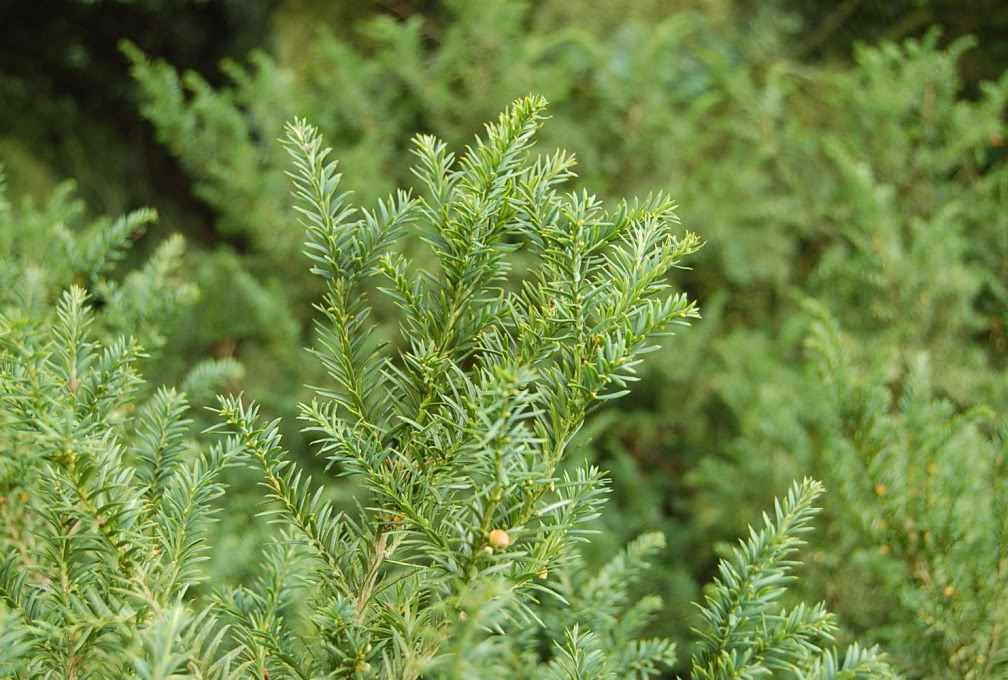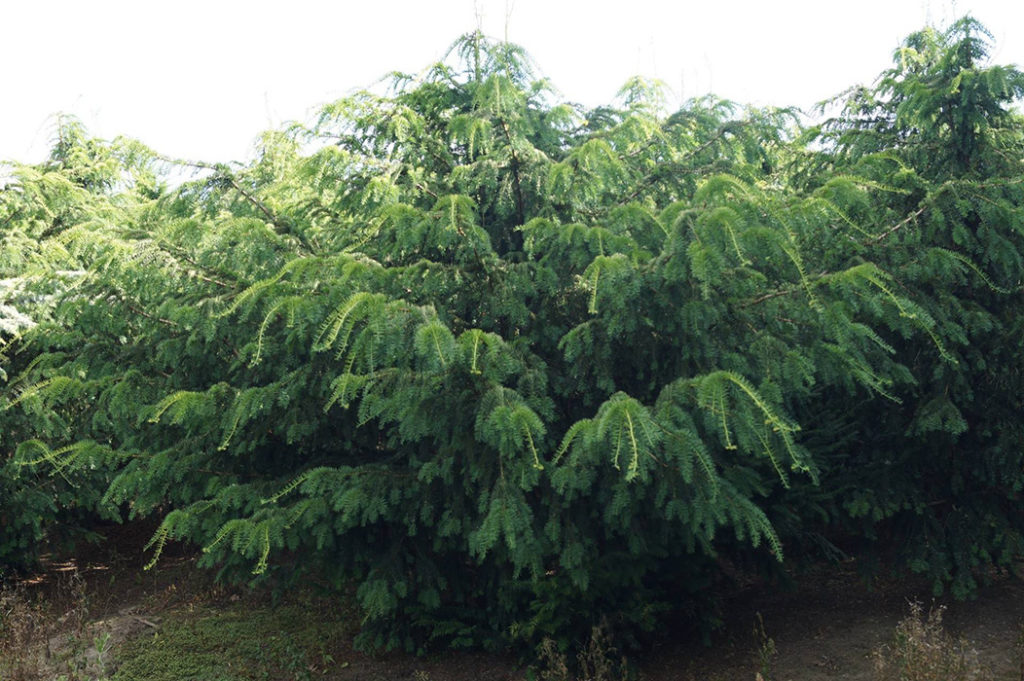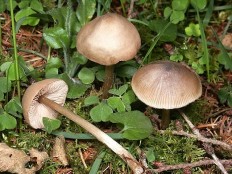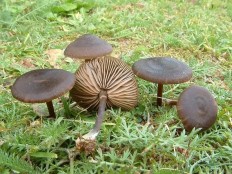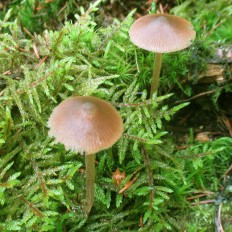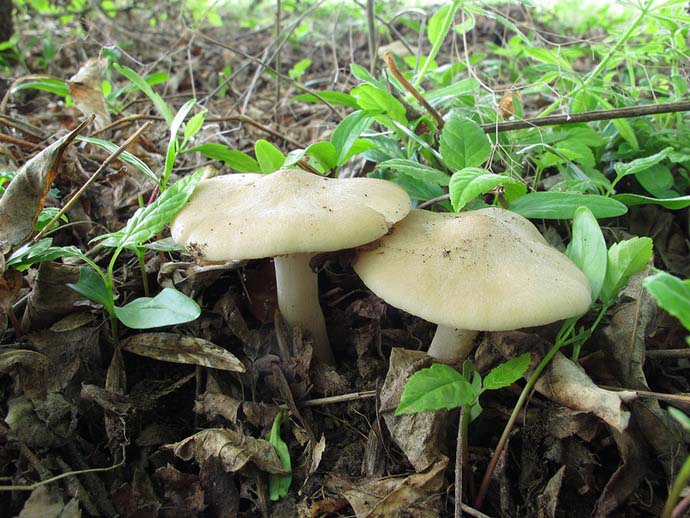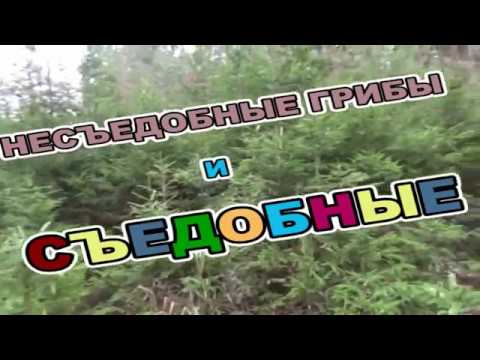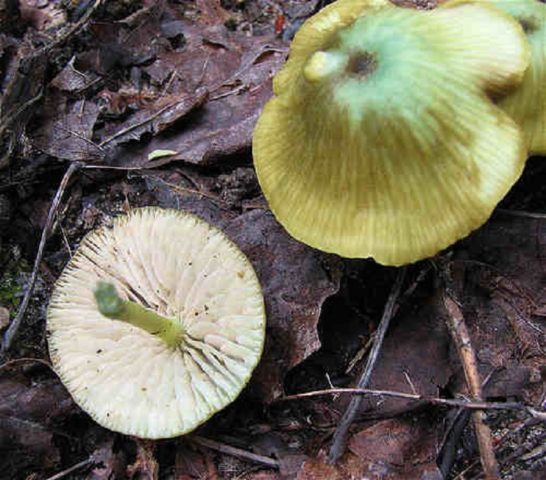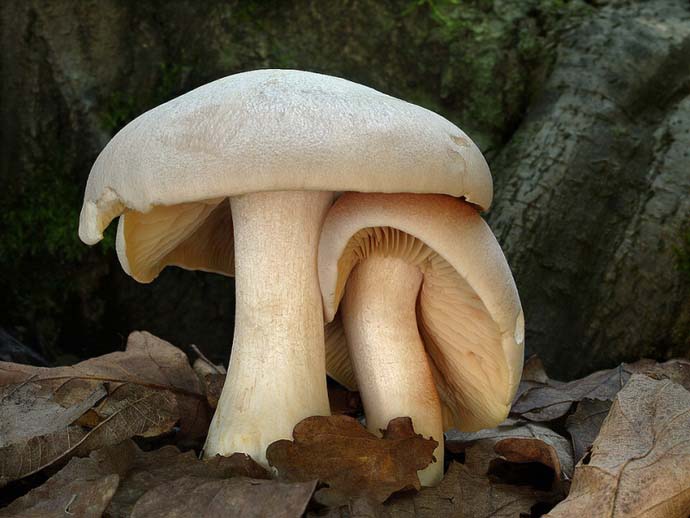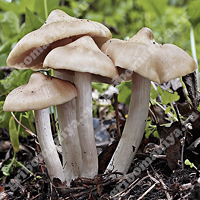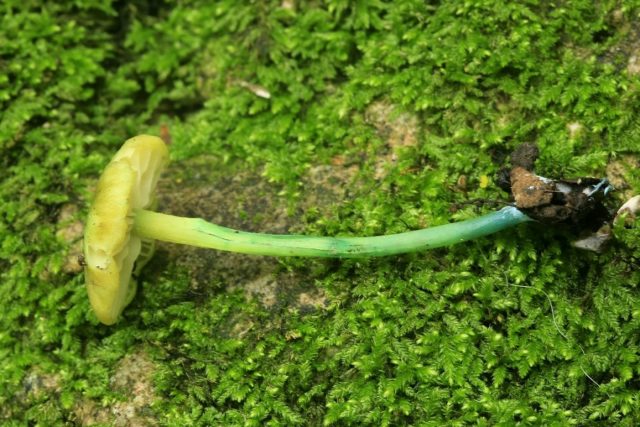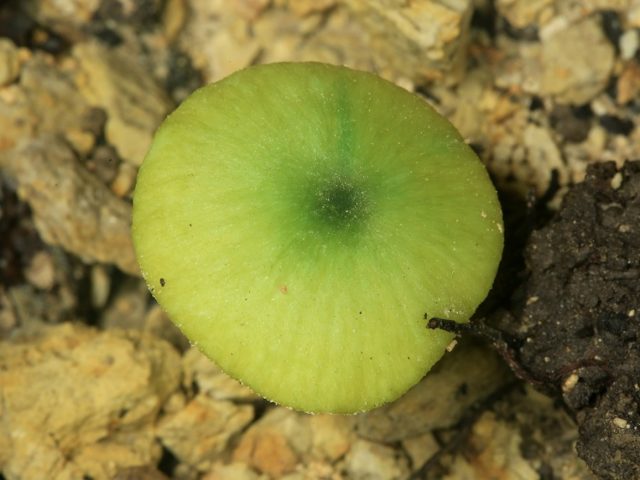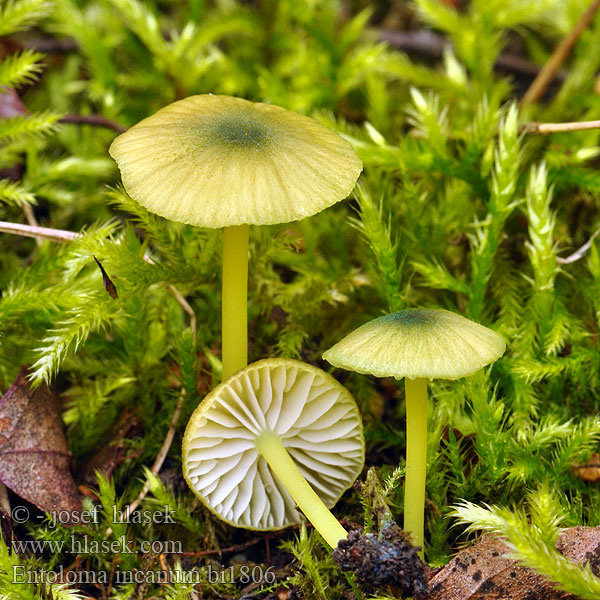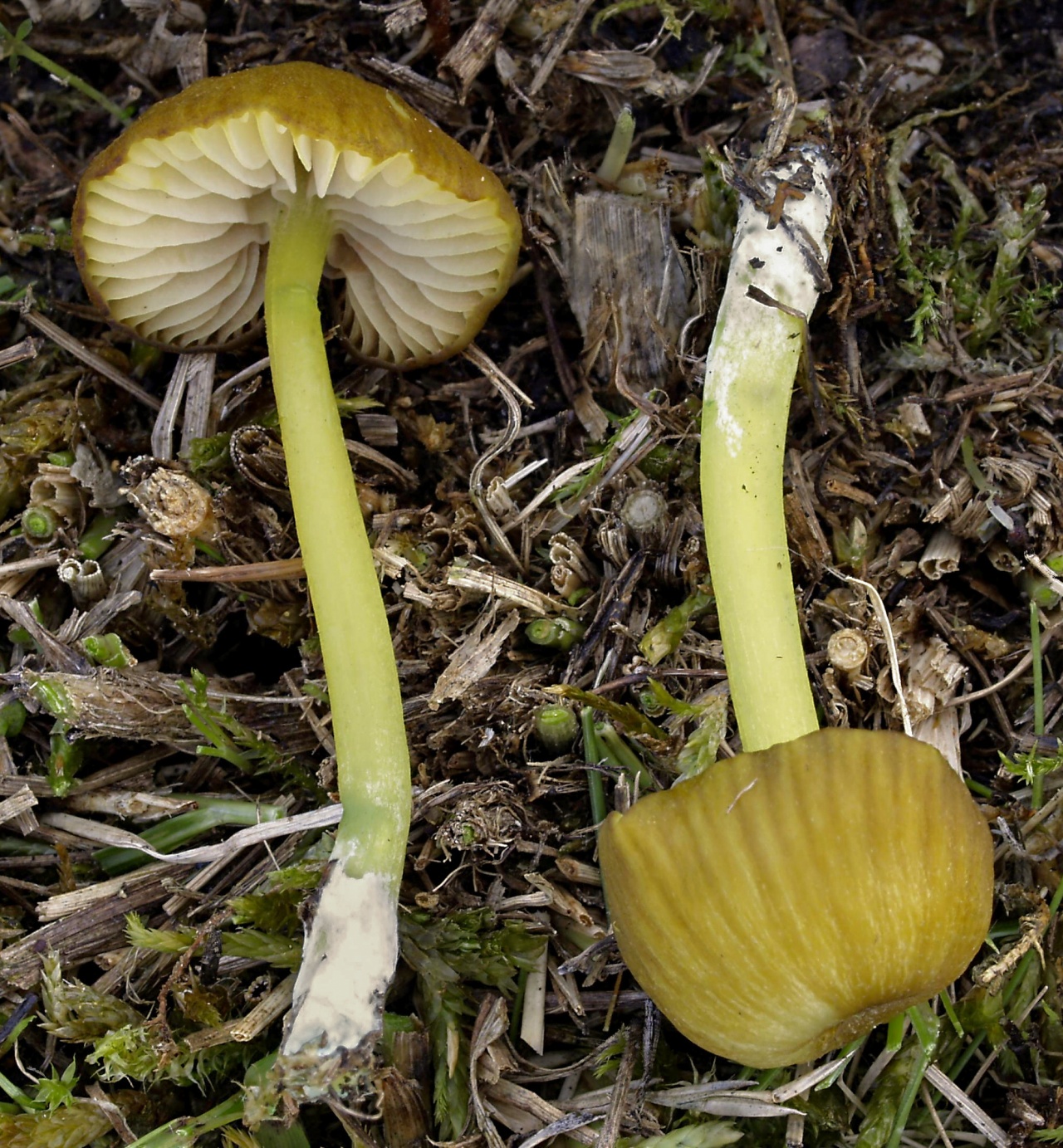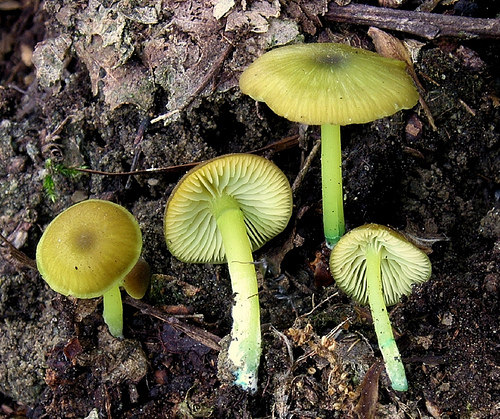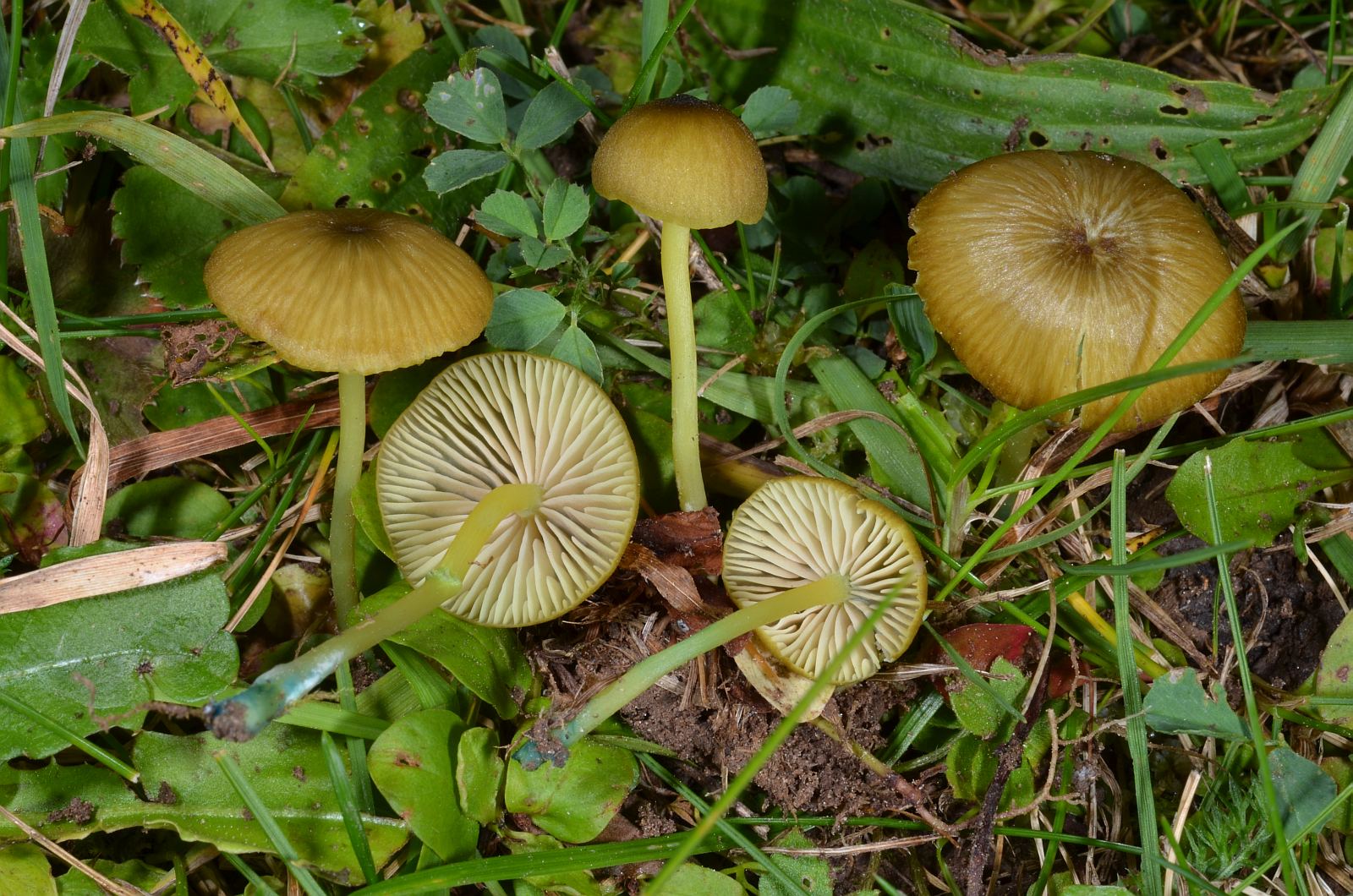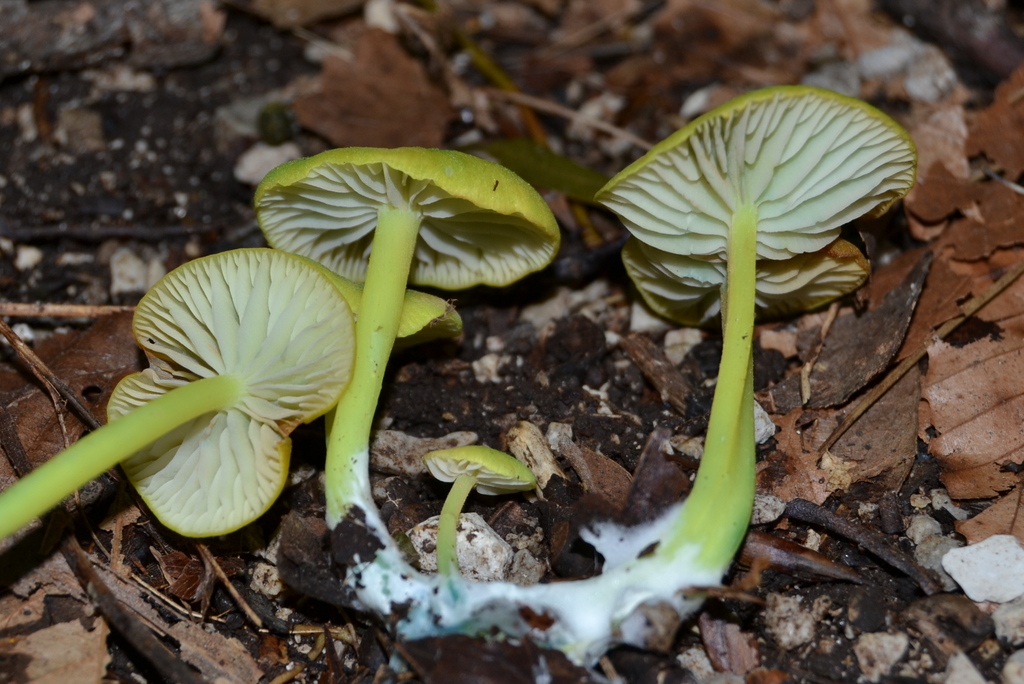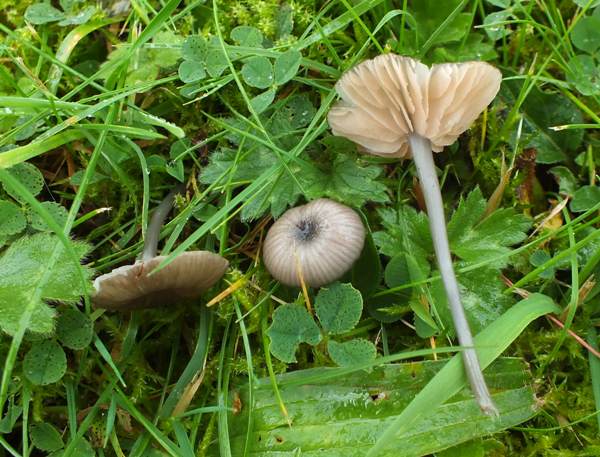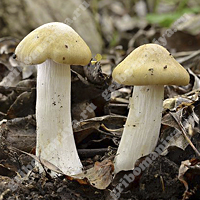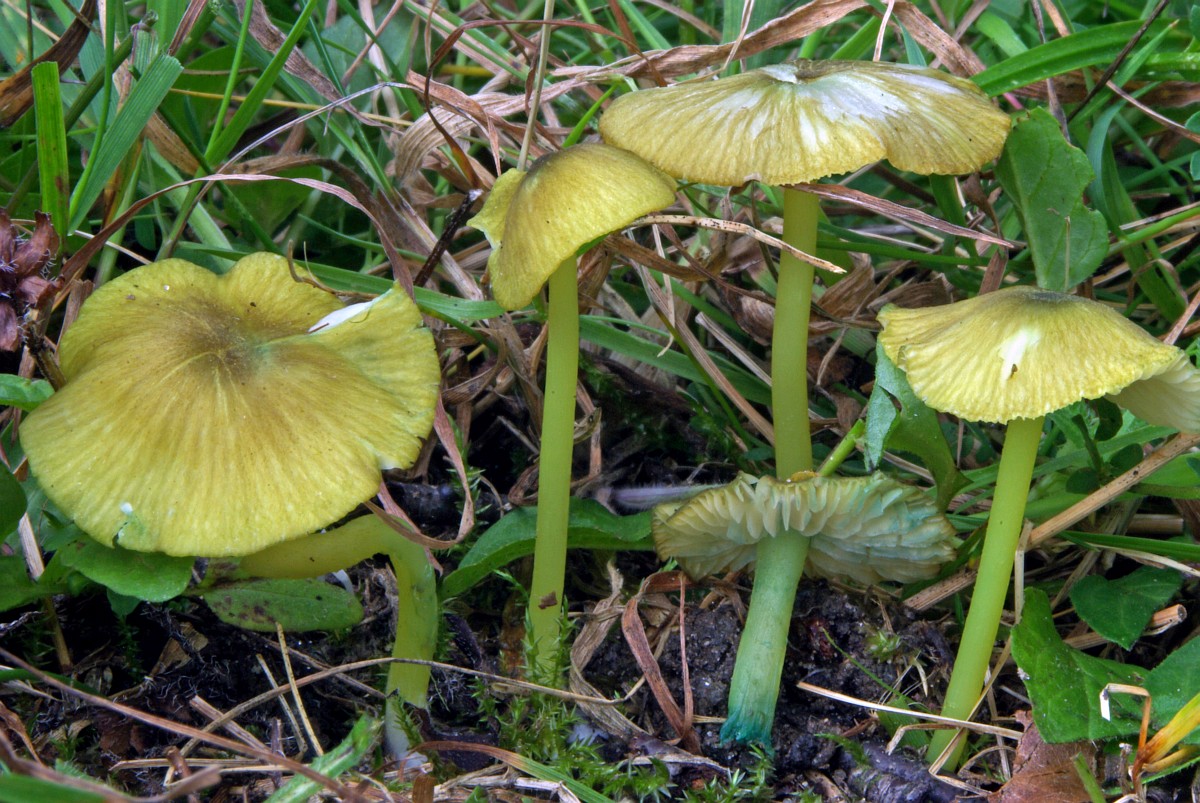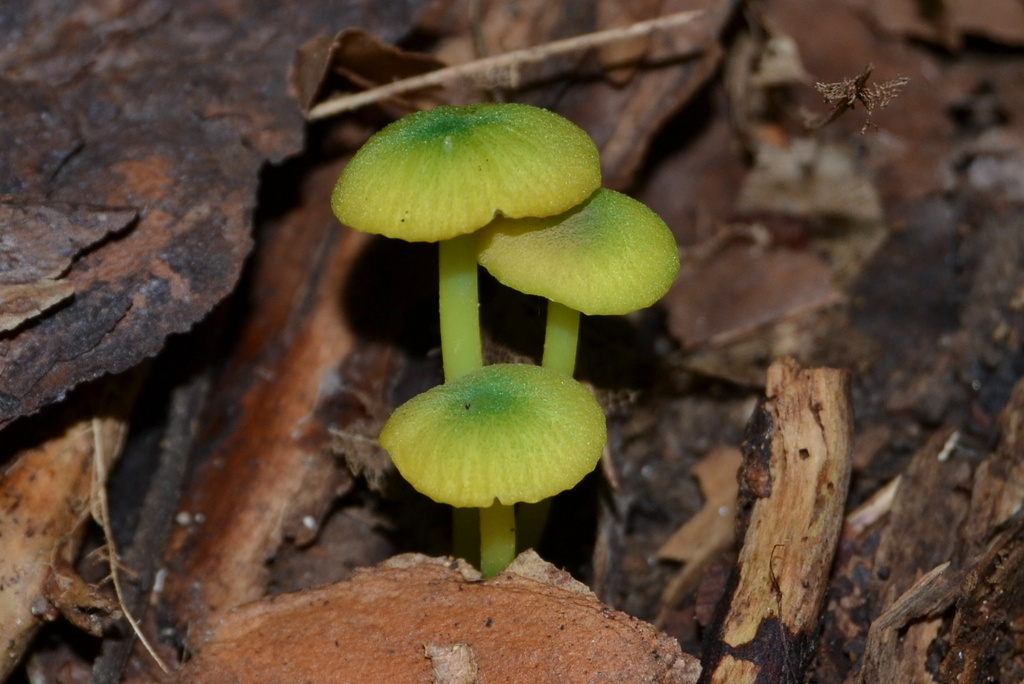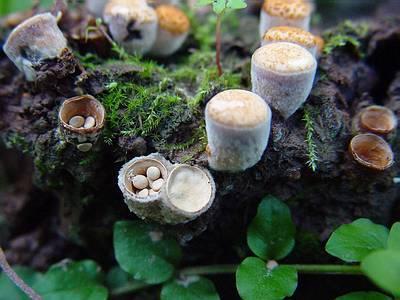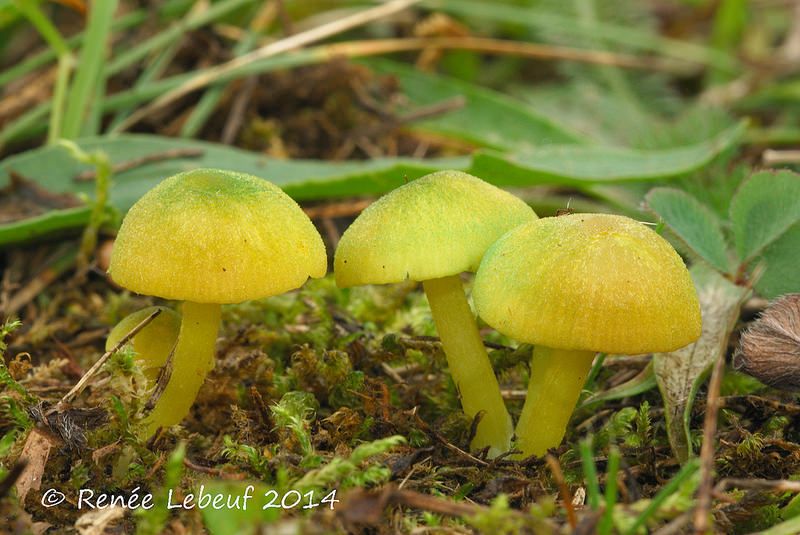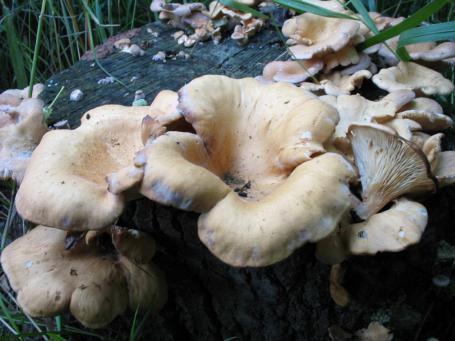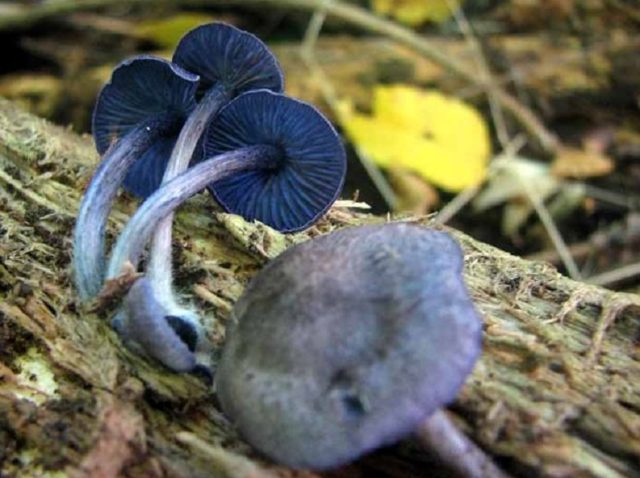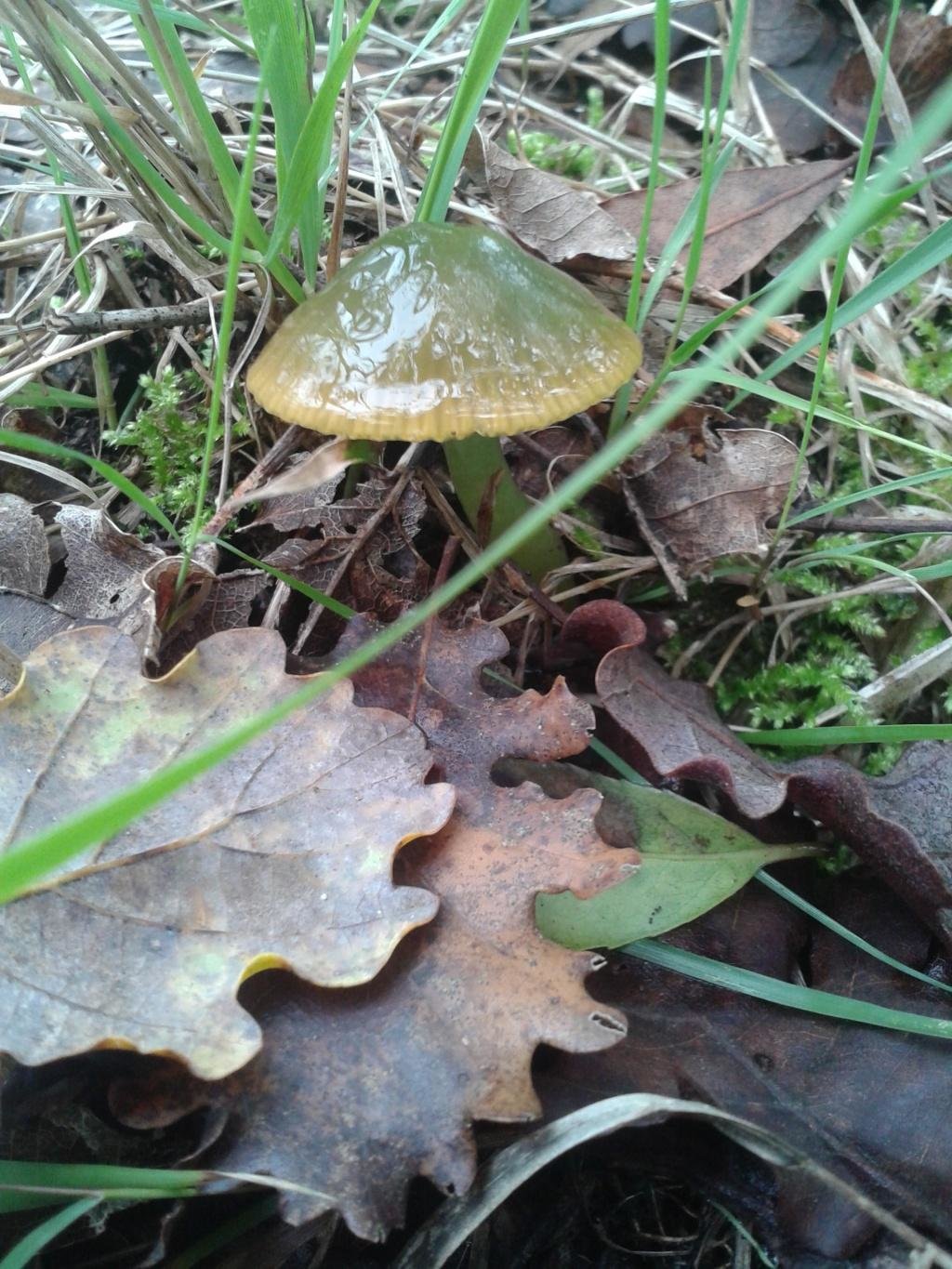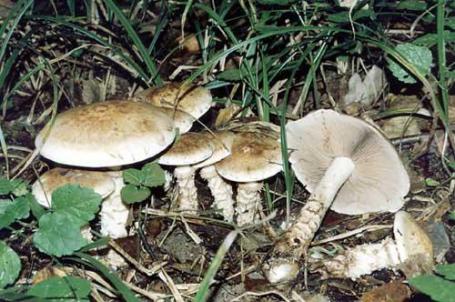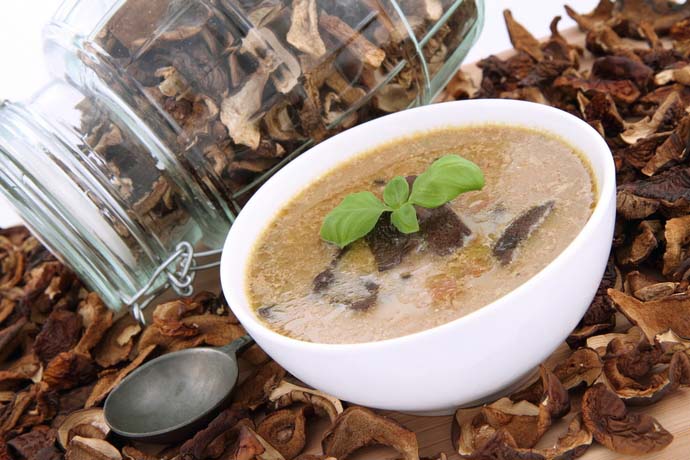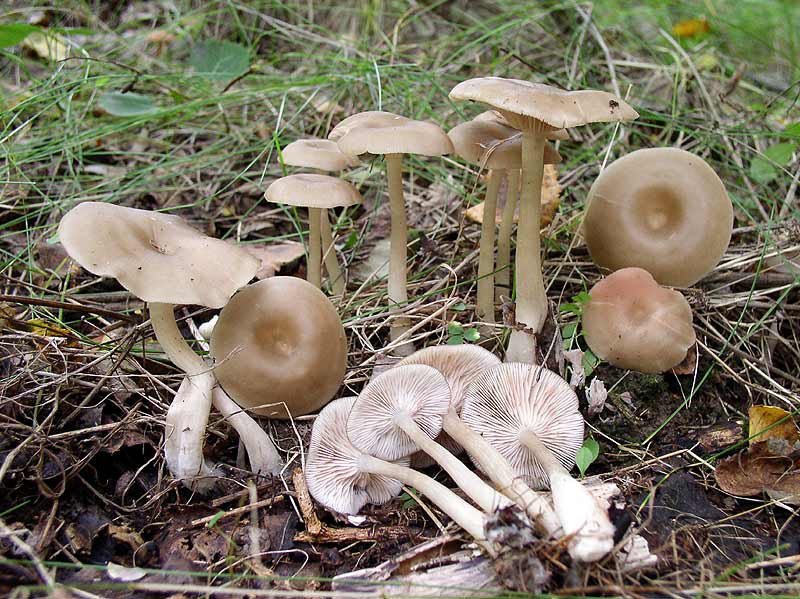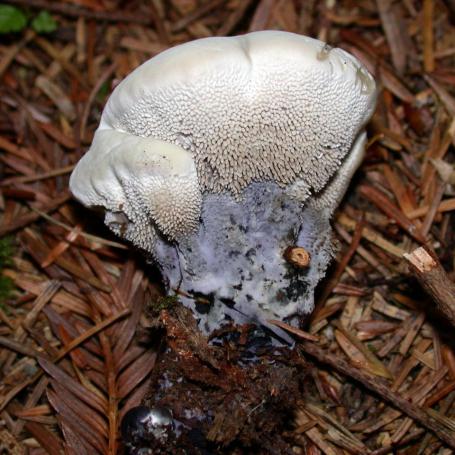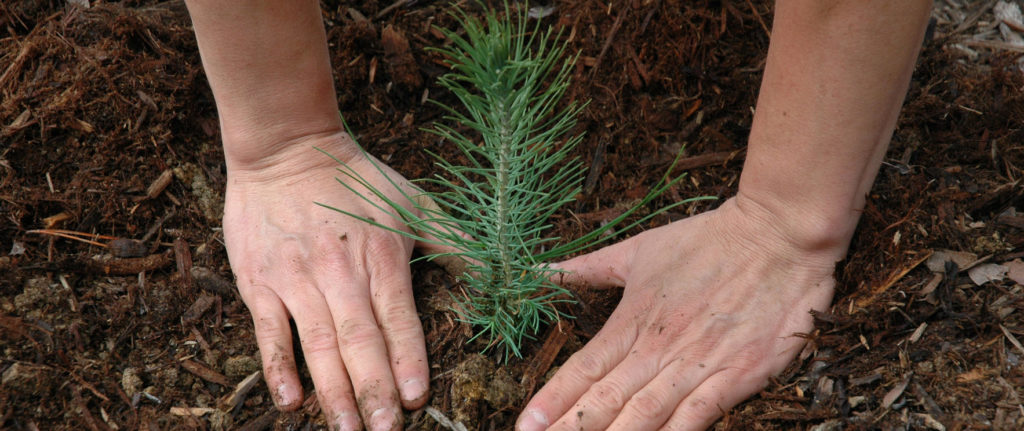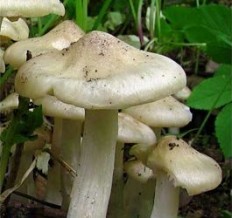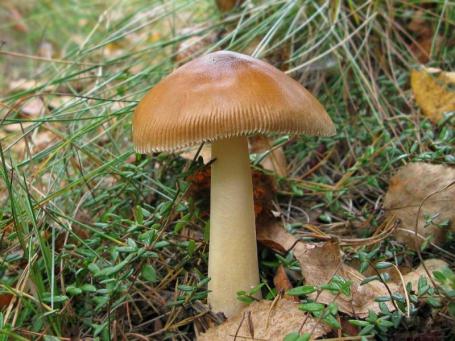Entoloma clypeatum
- Other names for the mushroom:
- Entoloma garden
- Entoloma edible
- Thyroid rosacea
- Entoloma thyroid
- Shield entoloma
- Entoloma forest
- Podlivnik
- Podrikosovik
- Podzherdelnik
OTHER NAMES:
DESCRIPTION:
The hat of an entoloma garden with a diameter of 7 to 10 (and even 12) cm.In youth it is bell-conical or convex, then unevenly spread and convex-concave, often with a tubercle, smooth, sticky in the rain, darker, in dry weather - silky fibrous, lighter. Its edge is uneven (wavy), sometimes with cracks.
The color of the cap varies from whitish-gray, beige and gray-brownish to grayish and gray-brown. The plates of the entoloma are wide, rather rare, adherent to the pedicle with a tooth, with a serrated edge, of unequal length.
In adolescence, entolomas are whitish, then they become pale pink, dirty pink or gray-brownish, and in old age they acquire a reddish tint. The pinkness of the plates is the main distinguishing feature of all enthol. A cylindrical, often curved, often twisted leg reaches a height of 10, sometimes 12 cm, in thickness - from 1 to 2 (and even 4) cm.It is brittle, longitudinally ribbed, solid, in old age, hollow, sometimes twisted, slightly under the cap furrowed.
The leg is whitish, pinkish or grayish in color. And its slightly thickened base is lighter. The ring on the leg is always missing. The pulp of entoloma is dense or soft, fibrous, white or brownish, with a weak mealy taste and smell, or even insipid.
Spore powder of pink color.

HABITAT AND GROWTH TIME:
Blackthorn entoloma grows in deciduous and mixed forests under rowan, birch and oak trees - on nutrient-rich soil, along roads, in meadows, in gardens and on city lawns. In the garden, it often grows under fruit trees (apple and pear) and bushes of roses, rose hips, hawthorns and blackthorns.
It is widespread and common on the territory of the Leningrad region and in St. Petersburg, although it grows pointwise - from the last five days of May to the end of July with the most massive fruiting in June and in a wet, cool summer - and in July. Often it gives not one, but several short layers. Thorny entoloma rarely appears alone, usually grows in groups, often in large.
TWINS:
There is a very similar mushroom - the edible entoloma pale brown (Entoloma sepium) with a creamy, brownish-gray and even gray-brownish-greenish cap, emarginate-descending plates, white, shiny, long-fibered stem. Grows on lawns, gardens and bushes from late May to June.
The main task is not to confuse these two edible entolomes with Entoloma sinuatum or Poisonous Entoloma. The main differences of E. poisonous: a larger size (a cap up to 20 cm in diameter), a lighter (dirty whitish, creamy gray, grayish ocher and yellowish) cap with an easily removable skin, yellowish (in youth) plates, thicker ( up to 3 cm in diameter), a clavate leg, one-color with a cap, and a faint unpleasant smell of pulp. But this smell can be almost imperceptible. It is not found in the north of Russia.
There are two more relatively similar poisonous entolomes. Entoloma pushed through (Entoloma rhodopolium) with a thin yellow-cream, gray or brownish cap and ammonia odor. It grows from August to early October. And Entoloma spring - darker, shallow, slender and growing from the end of April to the last five days of May, that is, does not overlap with Entoloma Sadovaya in terms of timing.
EDIBILITY:
This is a conditionally edible mushroom. Boil entoloma for 20 minutes, and then put it in a roast, pickle or pickle. In southern Russia, dishes from it are from the category of traditional mushroom dishes, and in Western Europe, it is considered one of the best mushrooms.
Video about the mushroom Entoloma blackthorn:
NOTES:
The word "clypeatum" in the name of the mushroom means "shaped like a shield." Widespread on the globe: Western Europe, Ukraine, European Russia and North America. Appears in warm regions in April.The genus Entoloma has 153 species, among them there are edible mushrooms, but in order to use them for food, you need to be an experienced mushroom picker. The clearest photographs and the best descriptions cannot save you from error, so be careful with these mushrooms!
Definitioner
- Basidia (Basidia)
-
Lat. Basidia. A specialized structure of sexual reproduction in fungi, inherent only in Basidiomycetes. Basidia are terminal (end) elements of hyphae of various shapes and sizes, on which spores develop exogenously (outside).
Basidia are diverse in structure and method of attachment to hyphae.
According to the position relative to the axis of the hypha, to which they are attached, three types of basidia are distinguished:
Apical basidia are formed from the terminal cell of the hypha and are located parallel to its axis.
Pleurobasidia are formed from lateral processes and are located perpendicular to the axis of the hypha, which continues to grow and can form new processes with basidia.
Subasidia are formed from a lateral process, turned perpendicular to the axis of the hypha, which, after the formation of one basidium, stops its growth.
Based on morphology:
Holobasidia - unicellular basidia, not divided by septa (see Fig. A, D.).
Phragmobasidia are divided by transverse or vertical septa, usually into four cells (see Fig. B, C).
By type of development:
Heterobasidia consists of two parts - hypobasidia and epibasidia developing from it, with or without partitions (see Fig. C, B) (see Fig. D).
Homobasidia is not divided into hypo- and epibasidia and in all cases is considered holobasidia (Fig. A).
Basidia is the place of karyogamy, meiosis and the formation of basidiospores. Homobasidia, as a rule, is not functionally divided, and meiosis follows karyogamy in it. However, basidia can be divided into probasidia - the site of karyogamy and metabasidia - the site of meiosis. Probasidium is often a dormant spore, for example in rust fungi. In such cases, probazidia grows with metabasidia, in which meiosis occurs and on which basidiospores are formed (see Fig. E).
See Karyogamy, Meiosis, Gifa.
- Pileipellis
-
Lat. Pileipellis, skin - differentiated surface layer of the cap of agaricoid basidiomycetes. The structure of the skin in most cases differs from the inner flesh of the cap and may have a different structure. The structural features of pileipellis are often used as diagnostic features in descriptions of fungi species.
According to their structure, they are divided into four main types: cutis, trichoderma, hymeniderma and epithelium.
See Agaricoid fungi, Basidiomycete, Cutis, Trichoderma, Gimeniderm, Epithelium.
- Cutis
-
The type of cap skin, consists of creeping non-gelatinized hyphae located parallel to the surface. The surface of the cap looks smooth.
Lat. Cutis.
See Gifa.
Description of the grayish lepton
The hat is thin, its shape is convex at first, but eventually becomes flat, and may even be slightly depressed in the center. The diameter of the cap does not exceed 4 centimeters. The cap is hygrophane, its surface is radially striated, wrinkled, wavy, sometimes there may be scales in the center. The cap has radial fibrous edges. The cap color can be yellow-green, light olive, golden brown and brown. The center is darker.

The stem is very thin, cylindrical, thickening is noticeable towards the base. It is covered with thick fluff. Its height is 2-6 centimeters, while its diameter does not exceed 2-4 millimeters. The leg is hollow in structure. Its color is bright, yellowish-green. The base of the stem is white, and in mature specimens it turns blue. A bluish-green tint appears at the fracture.
The plates are fleshy, wide, not often located. Between the large plates there are small plates. The shape of the plates is arcuate. They grow with teeth. In young mushrooms, the plates are whitish-green, and in adulthood they become pinkish.
The flesh is thin, watery, and emits a strong mousey odor. If you press on the pulp, it takes on a blue tint. Spore powder light pink.

Distribution of grayish leptonia
Gray leptonia grow in mixed and deciduous forests. They can be found in meadows and forest edges. Gray leptonia grow on alkaline infertile soils. They settle in large groups or singly. The fruiting period of grayish leptonia is August-September.
Leptonia grayish is a poisonous mushroom. It causes dangerous poisoning.

The similarity of grayish leptonia with other mushrooms
Outwardly, this mushroom is similar to many entoloma, which are yellow-brown in color. It should be borne in mind that there are a large number of poisonous representatives among entol. In particular, the grayish lepton is similar to the depressed entoloma, a characteristic feature of which is a depressed cap and often located white plates.
Distribution and places of growth
Poisonous entoloma, or poisonous rose leaf, is a relatively thermophilic mushroom. Distributed in the southern regions of Russia, comes across in the Caucasus, is well known to the inhabitants of Ukraine and the Republic of Belarus. This mushroom is rarely found in Karelia and the Murmansk region. In Western Europe, it practically does not occur - it is very rarely found in Austria and the mountainous regions of France.
He loves the neighborhood of hornbeam, beech, oak, sometimes it can be found near a willow or birch. Grows, as a rule, in small groups of 2-4 pieces. Favorite growing places are in the shade, under trees, in beams, on swampy soils with a high lime content.
Ecology and distribution
Most of the representatives of the genus are saprotrophs growing on soil in forests and on forest floor. Some species grow on old decaying wood. Some species of the subgenus Entoloma form mycorrhiza with various trees and shrubs from the Pink family (Rosaceae). Some species grow on other Basidiomycete fungi. The parasitic entoloma is found on the fruiting bodies of the common chanterelle.
Underdeveloped hat-stem fruiting bodies of entoloma often grow interspersed with shapeless, "underdeveloped" fruiting bodies that appear as a result of parasitizing this entoloma on some types of honeydew, including tolstonogo.
Representatives of the genus Entoloma are known on all continents, with the exception of Antarctica. Many species grow in barren grasslands in the Northern Hemisphere. The diversity of species growing in the tropical rainforests of Australia and New Zealand is also great.
Related species
Garden or edible entoloma is a conditionally edible mushroom. The hat can be bell-conical, outstretched and convex-concave, its diameter reaches 10 centimeters. The surface of the cap is smooth; it becomes sticky in the rain. The edges are wavy, sometimes with cracks. The color of the cap is whitish, beige, gray-brown, gray-brown. The leg is cylindrical, often bent, long - up to 12 centimeters in length. Its color is pink, whitish or grayish.
These mushrooms grow under oaks, birches, mountain ash. They can settle in forests, lawns, meadows, orchards. Fruiting occurs in May-July. Rarely do these mushrooms appear alone, most often they are found in groups. Before cooking, these conditionally edible mushrooms are boiled for 20 minutes.

Brightly colored entoloma is an inedible mushroom. A characteristic feature of this mushroom is a purple hat and blue plates. At a young age, the cap looks like a hemisphere, but over time it becomes almost flat, and there is a depression in the middle. In older mushrooms, the caps turn brown. The leg is hollow, with a slight bend, covered with scales. The color of the leg can be the same color as the cap or gray. The pulp is fragile, it tastes soapy, and the smell is specific, unpleasant.
These mushrooms are found on various continents, but they are very rare and rarely found. They bear fruit from September to October. They prefer deciduous forests, they can be found under alder, birch, oak, rowan and ash.Very rarely found in conifers.
Notes (edit)
- Vasilyeva L.N. Agaric cap mushrooms (por. Agaricales) of Primorsky Territory. - L.: Nauka, 1973 .-- P. 256.
- P. M. Kirk, P. F. Cannon, D. W. Minter, J. A. Stalpers. Ainsworth & Bisby's Dictionary of the Fungi. - 10th ed. - CAB International, 2008. - P. 237. - ISBN 978-0-85199-826-8.
- ↑ Bas, C .; Kuyper, T. W .; Noordeloos, M. E .; Vellinga, E. C .; Crevel, R. van; Arnolds, E. J. M. Flora Agaricina Neerlandica. - 1988. - Vol. 1.
- P. F. Cannon, P. M. Kirk. Fungal Families of the World. - CAB International, 2007. - P. 116-117. - ISBN 978-0-85199-827-5.
- Wasser S.P. Flora of mushrooms of Ukraine. Amanital mushrooms / otv. ed. K. A. Kalamees. - TO.: Naukova Dumka, 1992. - S. 41-87. - ISBN 5-12-003226-5.
- Noordeloos, Machiel (English) (inaccessible link). Entoloma. Date of treatment April 24, 2011.
- ↑ M. E. Peterson, P. A. Talcott. Small Animal Toxicology. - 2nd ed. - Elsevier Health Sciences, 2006. - P. 876. - 1190 p. - ISBN 0721606393.
- J. F. Ammirati, J. A. Traquair, P. A. Horgen. Poisonous Mushrooms of the Northern United States and Canada. - University of Minnesota Press, 1985. - P. 312-313. - 396 p. - ISBN 0816614075.
- E. R. Boa. Champignons Comestibles Sauvages. - Rome: Organization des Nations Uniens pour L'Alimentation et L'Agriculture, 2006. - Vol. 17. - ISBN 92-5-205157-0.
- Roody, W. C. Mushrooms of West Virginia and the Central Appalachians. - University Press of Kentucky (English) Russian, 2003. - P. 133-134. - ISBN 0813190398.
- Nilson, S., Persson, O. Fungi of Northern Europe 2: Gill-Fungi (unspecified). - Penguin, 1977 .-- S. 98 .-- ISBN 0-14-063006-6.
- Fries, E. M. Systema Mycologicum. - 1821. - Vol. 1. - P. 207.
- Fries, E. M. Epicrisis Systematis Mycologici. - 1838.
- Quélet, L. Enchiridion Fungorum in Europa media et praesertim in Gallia Vigentium. - 1886 .-- P. 57.
- Noordeloos, Machiel (English) (inaccessible link). Entoloma. Date of treatment April 24, 2011.
- Noordeloos, Machiel (English) (inaccessible link). Entoloma. Date of treatment April 24, 2011.
- Noordeloos, Machiel (English) (inaccessible link). Entoloma. Date of treatment April 24, 2011.
- Noordeloos, Machiel (English) (inaccessible link). Entoloma. Date of treatment April 24, 2011.
- Noordeloos, Machiel (English) (inaccessible link). Entoloma. Date of treatment April 24, 2011.
- Noordeloos, Machiel (English) (inaccessible link). Entoloma. Date of treatment April 24, 2011.
- Noordeloos, Machiel (English) (inaccessible link). Entoloma. Date of treatment April 24, 2011.
- Noordeloos, Machiel (English) (inaccessible link). Entoloma. Date of treatment April 24, 2011.
- Noordeloos, Machiel (English) (inaccessible link). Entoloma. Date of treatment April 24, 2011.
- Noordeloos, Machiel (English) (inaccessible link). Entoloma. Date of treatment April 24, 2011.
- Noordeloos, Machiel (English) (inaccessible link). Entoloma. Date of treatment April 24, 2011.
Biological description
The fruiting bodies of the cap-pectus, small, medium or rather large, are gasteroid in only some species. The type of development of fruiting bodies is hymnocarp, that is, there are no particular and general covers.
The cap is conical, bell-shaped, flat, plano-convex, convex or funnel-shaped, thin or fleshy. The surface of the cap is smooth, velvety or scaly. An important sign for the distribution of species into subgenera is hygrophilousness, that is, the ability to absorb water in wet weather, or non-hygrophilousness of the cap. In representatives of some subgenera, the edge of the cap is translucent and radially lined, while in others it is smooth and opaque.
The plates are adherent or narrowly adhered to the pedicle, descending onto it or with indentations and teeth running down onto the pedicle, only in some species almost free from it. The edge of the plates is even or slightly serrated. In addition to the plates, many species have plates.
The stem is absent or present, central or eccentric, short and fleshy, or thin and long, even or widening towards the base. The surface of the leg is smooth, velvety or finely scaly, striped in some species.
Angular spores of lead-white entoloma
The hyphal system of the fruiting bodies is monomytic, that is, the fruiting bodies of the entolome consist only of generative hyphae. Hyphae with or without buckles, non-amyloid.
Spore powder of pink or pinkish-brown color. Spores in all species are angular, thin or thick-walled. Basidia are two- or four-spore. Cheilocystids - cystids located at the edges of the plates - are most often present, pleurocystids, that is, cystids on the surface of the plates, are absent in most species. The cuticle of the cap (pileipellis) in different species has a different structure: it can be cutis, trichodermis or hymenodermis. Hyphae with or without buckles. Short (30-100 μm), swollen or cylindrical hyphae are characteristic, for example, of the subgenus Entoloma, long fusiform hyphae - for Nolanea... The tram of the plates and the cap is correct, that is, their hyphae are almost not intertwined, but are located parallel to each other.
Similar species from other genera
Fruiting bodies of many entoloms resemble representatives of other, sometimes unrelated genera. One of these genera is Plyutey (Pluteus) from the Plutey family (Pluteaceae). However, representatives of this genus are markedly different from entola - their pinkish plates are always free from the stem. Representatives of some related genera are also outwardly similar to entolomes. For some clitopiluses (Clitopilus) are characterized by descending plates and the absence of cystids, as in many enthol. Some species form mycorrhiza.In other representatives of this genus, previously isolated in the genus Rhodocybe (Rhodocybe), plates adhered to the pedicle or descending to it, the cap is depressed in the center. However, representatives of all these genera are very different from enthol in the form of spores - unlike angular spores with entol, in representatives of these genera they are round, oblong, warty or striped.
Similar species
There are many edible mushrooms that are similar in appearance to the poisonous rose leaf, which poses a danger to novice mushroom pickers. Most often, fans of "mushroom hunting" confuse entoloma with the following mushrooms:
- pendant - the color is almost identical, the difference is in the plates descending to the leg;
- smoky ryadovka - differs in smaller plates, the color of which is noticeably lighter;
- pigeon ryadovka - differs in a hat, on which colored spots are noticeable, and flesh turning pink on the cut;
- smoky talker - it has a peculiar floral or putrid smell, the plates are narrower and lighter;
- common champignon - is distinguished by the presence of a ring on the leg and dark-colored plates;
- rose-leaf garden - an edible mushroom that grows in gardens and meadows, differs in that its cap has a hygrophilous property (swells when wet).
Edible and Poisonous Species of the Yellow Spiderweb Mushroom

